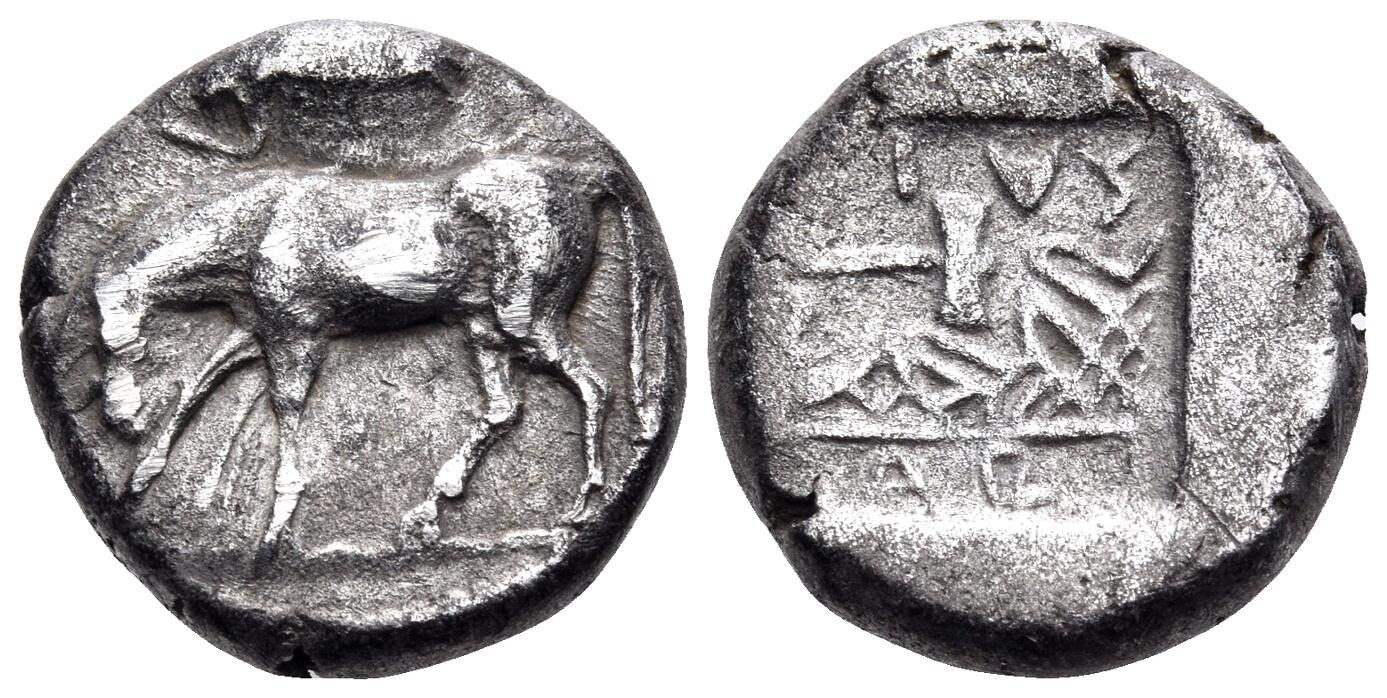3238 - Larissa (drachma Thessalos/horse) over Larissa (horse/sandal) (Triton, XV, Jan. 2012, 152)
From SILVER
460 BCE - 440 BCE | ΛΑRI
Location/history
| Sale(s)Sale(s) ᵖ: | Triton, XV, 3 Jan. 2012, 152 = Roma Numismatics, 5, 23 March 2013, 173 = Roma Numismatics, 8, 28 Sept. 2014, 146 = Roma Numismatics, 11, 7 Apr. 2016, 135 = Triton, XXVII, 9 Jan. 2024, 171 | |
| Private collection(s)Private collection(s) ᵖ: | BCD Collection |
Overstriking coin
Description
| ObverseInscription or printing placed on the obverse.: | Thessalos advancing right, with petasos over his shoulders and chlamys tied at his neck, holding a band around the forehead of a bull rushing to right. Below, lotus flower. Border of dots. | ReverseInscription or printing placed on the reverse.: | ΛΑRI (Greek) Horse prancing left, trailing rein, within incuse square. |
Mint and issuing power
| MintIdentifies the place of manufacture or issue of a numismatic object.: | Larissa | Ancient regionAncient region. | Thessaly | Modern countryModern country: Greece | AuthorityIdentifies the issuing power. The authority can be "pretended" when the name or the portrait of X is on the coin but he/she was not the issuing power. It can also be "uncertain" when there is no mention of X on the coin but he/she was the issuing power according to the historical sources: |
Chronology
| FromIdentifies the initial date in a range assigned in a numismatic context. 460 BCE toIdentifies the final date in a range assigned in a numismatic context.. 440 BCE | Classical 480-323 BC |
Physical description
| MetalThe physical material (usually metal) from which an object is made.: Silver |
WeightWeight of the numismatic object (in grams). in grams: 5.855.85 g <br />5,850 mg <br /> | DenominationTerm indicating the value of a numismatic object. Examples: tetradrachm, chalkous, denarius.: drachma |
AxisDescribes the directional relationship between the obverse and reverse of a numismatic object.: 33 mm <br />0.3 cm <br /> |
| DiameterDescribes diameter of an object (in mm).: 2222 mm <br />2.2 cm <br /> | StandardStandard.: Aeginetic | ||
References
| Coin referenceReference of the Coin: | https://www.acsearch.info/search.html?id=3019925 | Coin series referenceReference to coin series study: | HGC 41HGC 4, n°411 |
| Coin series web referenceCoin series web references: | |||
Overstruck type
Description
| ObverseInscription or printing placed on the obverse.: | Horse grazing left. Above, caduceus. Below, dog left. | ReverseInscription or printing placed on the reverse.: | ΛΑRΙ-ϞΑΙΟ-Ν (Greek) Sandal of Jason and double axe within incuse square. |
Mint and issuing power
| MintIdentifies the place of manufacture or issue of a numismatic object. ᵖ: | Larissa | Ancient regionAncient region. ᵖ | Thessaly | Modern countryModern country: Greece | AuthorityIdentifies the authority in whose name (explicitly or implicitly) a numismatic object was issued. ᵖ: |
Chronology
| FromIdentifies the initial date in a range assigned in a numismatic context. 500 BCE toIdentifies the final date in a range assigned in a numismatic context.. 479 BCE | Archaic until 480 BC |
Physical description
| DenominationTerm indicating the value of a numismatic object. Examples: tetradrachm, chalkous, denarius. ᵖ: | drachma |
References
| Coin type referenceReference to coin series study ᵖ: | HGC 41HGC 4, n° 393 | ||
| Coin series web reference overstruckCoin series web references overstruck: | |||
Additional data
| Frequency of overstrikesFrequency of overstrikes: | frequent | Level of confidenceLevel of confidence of the identification: | strong |
| RemarksRemarks: | "This particular coin is overstruck on an early sandal-type drachm. The reuse of the earlier coinage in this manner explains why they are so rare today" | ||
References
- a b Hoover, Oliver D. (2014), Handbook of Greek Coinage Series 4. Northern and Central Greece : Achaia Phthiotis, Ainis, Magnesia, Malis, Oita, Perrhaibia, Thessaly, Akarnania, Aitolia, Lokris, Phokis, Boiotia, Euboia, Attica, Megaris and Corinthia, sixth to first centuries BC, Lancaster, lxxi, 563 p.

